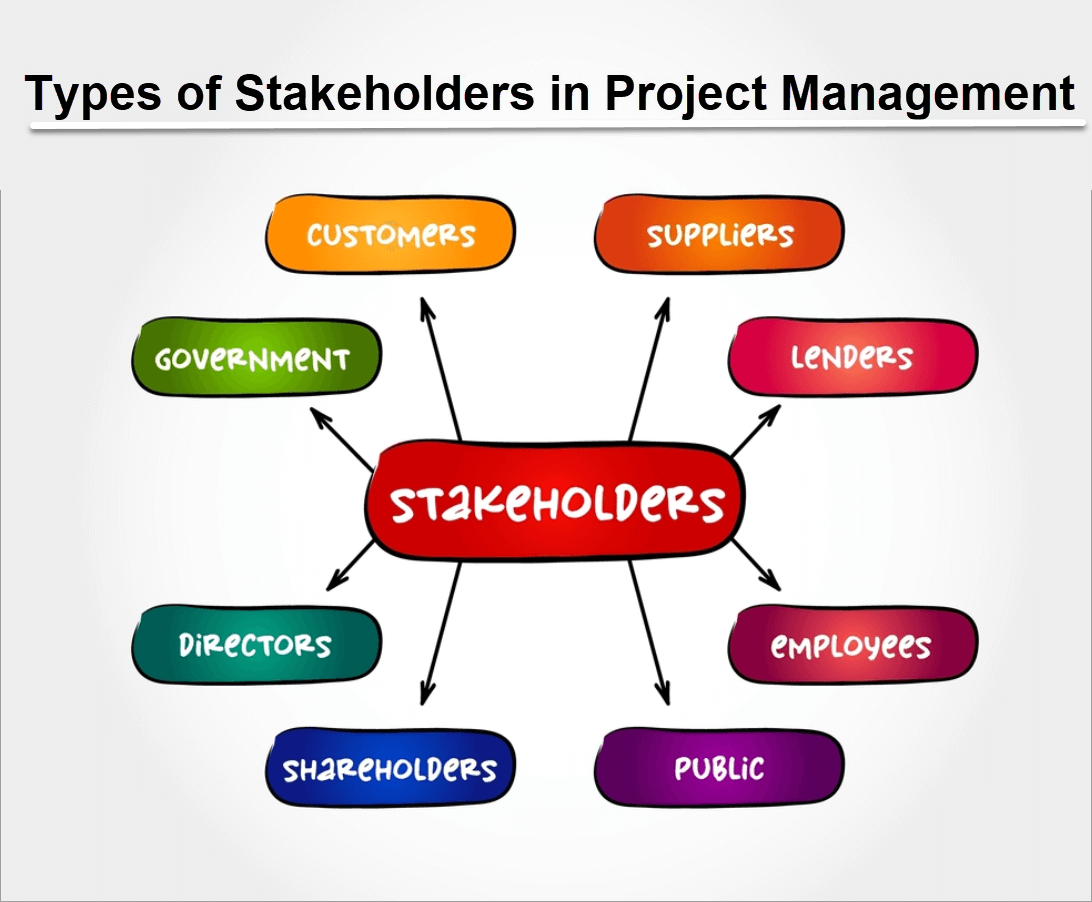A project cannot be carried out by a single individual. Irrespective of the size of the project, several individuals and organizations are involved in performing project-related tasks. Any personnel closely working with the project can be defined as stakeholders. To accomplish the goals and objectives of a given project, project managers should understand their relationship with stakeholders. Therefore, identifying project stakeholders is an important aspect of project management.

Jump ahead to
Who is a Stakeholder?
Project Management Body of Knowledge Guide (PMBOK Guide) 7th Edition by the Project Management Institute (PMI) defines Stakeholders as “Individuals, groups, or organizations that may affect, be affected by, or perceive themselves to be affected by a decision, activity, or outcome of a portfolio, program, or project. Stakeholders also directly or indirectly influence a project, its performance, or outcome in either a positive or negative way”. There are different types of stakeholders who can be involved in a specific project. These stakeholders keep varying for different kinds of projects.
Project Managers collaborate with project stakeholders to take the project from its initiation to completion. Since there are several types of project stakeholders with varying levels of interest in the project, identifying project stakeholders should be approached from the start of the project. This process of identifying stakeholders in project management is crucial to understanding the involvement of each project stakeholder.
The project manager has the responsibility of identifying the project stakeholders and outlining their level of involvement prior to their actual participation. Throughout the course of the project, they should also keep all stakeholders informed, involved, and on board. Therefore, to work together on the project, effective stakeholder management must be implemented together with constant communication. By doing this, they will be able to finish the job with the fewest obstacles possible and gain their support.
Who are the Different Types of Stakeholders?
Generally, stakeholders classified as primary stakeholders and secondary stakeholders. These are individuals or groups who are directly affected by the outcome of the project, and they have significant influence and decision-making power. However, Secondary stakeholders are not directly affected by the project and have a lesser degree of influence.

Types of Primary Stakeholders
Project Manager
A project manager is an individual who accepts to develop the project taken up by the organization. He/She would be responsible for picking the project team members who can carry out project-related tasks efficiently. Project manager’s role will be as a team leader while performing any given project for the organization. Also, without the guidance of a project manager/team leader, a project team cannot develop the deliverables.
Project Team
The project team is responsible for developing the project and delivering the intended outcomes. It consists of several individuals who possess specialized skills. Every team member has to coordinate with other team members while carrying out a project. In addition, project team members should report to the project manager in case of project-related issues.
PMOs
PMOs or Project Management Offices instilled with large organizations. Such offices define and maintain the standard for managing projects. PMOs indulge in specifying the policies, practices, and procedures for the effective management of projects.
Management
Management refers to the higher authorities present within the organization. Higher authorities oversee the progress of the project at regular intervals. In addition, without the approval of higher authorities, the project manager cannot execute the project. Every project related decision should communicated with the higher authorities by the project manager.
Customers
Customers can be a single individual or an entire organization who proposes the project. A project is built entirely upon the customer’s needs and requirements. As a result, customers are capable of directly affecting the success rate of the project. Projcet Managers cannot assessed project success until the customer is satisfied with the results.
End Users
End users are individuals who ultimately use the end results of the project. Such individuals act as beneficiaries of the project outcomes. A project’s success depends on the satisfaction level of end users. If the intended outcomes of the project do not meet the needs of end users, a project becomes a failure.
Types of Secondary Stakeholders
Suppliers
Suppliers can be individuals or organizations that provide resources for a given project. Every project requires certain inputs in the form of raw materials, IT services, spare parts, and so on. Therefore, suppliers become external stakeholders in supplying resources whilst operating outside the organization. In addition, without suppliers, a project will not have the necessary inputs for delivering desired outcomes.
Regulatory Bodies
Regulatory bodies indirectly affect the outcomes of the project. A project manager should follow all the regulations while developing the project. Not conforming to the regulations applicable for the project leads to project failure. In turn, an organization that does not follow the regulations loses its fame in the industry.
Governing bodies
Governing bodies are also known as project sponsors. A project sponsor is responsible for governing the management, project team, and other stakeholders. Without a project sponsor, a project cannot exist. In addition, project sponsors can be within the organization or outside the organization. Such individuals oversee the development of the project and its deliverables from the planning stage to the closure stage.
Summary
In project management, stakeholders are individuals or organizations that directly or indirectly influence a project’s success. They are broadly classified into primary and secondary stakeholders. Primary stakeholders include project managers, project teams, PMOs, management, customers, and end users those who are directly impacted by the project’s outcomes. Secondary stakeholders, such as suppliers, regulatory bodies, and governing bodies, play supportive or indirect roles. Identifying and managing and engaging stakeholders is crucial for smooth project execution, effective communication, and goal achievement.
Conclusion
Apart from the common stakeholders and their roles mentioned above, there can be other stakeholders as per project needs. Project Management Professionals (PMPs) must play a leading role in identifying project stakeholders and managing their relationships with every stakeholder. Every type of stakeholder plays a critical role in the success of the project. As a result, project professionals indulge in developing different strategies for each kind of stakeholder. By identifying stakeholders in project management, organizations can become more productive and deliver projects more consistently.
Professionals willing to master the techniques of supporting various stakeholders and identifying project stakeholders can enroll in the Effective Stakeholder Engagement Training Course. The PMP Certification assist project professionals in gathering advanced skills in project management. Taking up the certification enables individuals to gain knowledge of Project Management as a whole along with industry-standard practices. Additionally, this PMP Training will help aspiring project managers to understand the roles and responsibilities of each project stakeholder and help them in the identify stakeholders process. Thus, helping organizations gain a competitive edge over the rest of their competition and reach long-term project management success.
FAQs on Stakeholders in Project Management
1. Who is considered a stakeholder in project management?
A stakeholder is anyone who has an interest in or is affected by the project’s outcome Such as clients, team members, sponsors, or end-users.
2. Why is identifying stakeholders important in a project?
It helps project managers understand expectations, manage communication, and ensure all key interests are addressed for project success.
3. What are the two main types of stakeholders?
The two main types are primary stakeholders and secondary stakeholders.
4. Who are the primary stakeholders in a project?
Primary stakeholders are directly affected by the project, such as customers, project sponsors, team members, and investors.
5. Who are secondary stakeholders in a project?
Secondary stakeholders are indirectly affected, such as government agencies, suppliers, media, and the general public.
6. How do stakeholders influence a project’s success?
Their support, feedback, and decisions can impact project goals, timelines, and resource allocation, making them crucial to success.
7. How can professionals improve stakeholder management skills?
By enhancing communication, building trust, managing expectations, and gaining training through courses like Stakeholder Management Certification, which provides practical tools and strategies.



